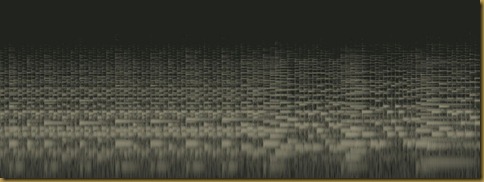My new favorite (and free) music player, Foobar, has a spectrogram visualization tool built in by default. I haven’t really looked at spectrograms before, but I have looked at lots of sheet music, so the idea of tying the heard to the seen is nothing new to me.
I soon found myself entranced by trying to make sense of this sort of visualization. It plots time on the x-axis and frequency (on a logarithmic scale, which is how we hear music) on the y axis. The brightness of a marking represents the intensity of a frequency. Keep in mind that most instruments play with several harmonics at once—the different combinations of harmonics are what make a guitar sound different from a flute or a piano.
When you consider that most music has lots of voices going at it at the same time, each with their uniquely overlaid harmonics, it’s obvious that the spectrograph of a piece of music is going to be damned complex.
After you watch it for a time, though, it feels eerie how you can begin to “see” the sounds. You can tell a raspy voice from a pure one, and trace melodies across the landscape like ghosts in a storm.
As bewildering as it is for the eyes, though, our ears and brains take it in effortlessly, all the time, and it makes us feel great. This is perhaps even more fascinating: that there’s a mechanism to translate fluctuations in air-pressure into what we experience as music.
Here’s a part of Bach’s Art Of Fugue which is played on the organ. Look at those isolated tones with their perfect, evenly repeating harmonics.
Here’s Glenn Gould playing the C Minor Prelude from the Well Tempered Clavier Book I. Three things stand out for me: the geometrically steady rhythm, the cross spectrum regularity of the piece, and the subtly dramatic affect created by the slight sustaining of those bass notes against all this activity.
Here’s Gould is playing the C Minor Fugue. Again, the rhythmic regularity is impressive, and in this case it sets the stage for the playful interweaving of melodic lines.
And here’s some ambient electronica, the sort of stuff you might put on to meditate to, or to help you fall asleep. There’s a slow melodic rise and fall here. It’s so gradual it’s felt more than heard. This is music in slow-motion, and it draws a scene like a windblown Martian landscape.
Who would have thought that at this age I would find a new way to listen to music? There are times when I absolutely adore technology.




No comments:
Post a Comment